Computer software tackles bullying in schools

Professor Kerstin Dautenhahn from the University of Hertfordshire’s School of Computer Science and her interdisciplinary research team is part of a European consortium which has developed interactive role-play software which is designed to tackle the problem.
The project, which is called e-CIRCUS (Education through Characters with emotional Intelligence and Role-playing Capabilities that Understand Social interaction) (www.e-circus.org), will allow pupils to interact with ‘characters’ in a virtual school where bullying takes place.
“The pupil can witness the virtual bullying as an observer and is provided with the possibility of assisting the victim as their “invisible friend,” said Professor Dautenhahn.
“Hence pupils can learn vicariously about the disastrous consequences of bullying, and by developing an empathic relationship towards the virtual victim come up with strategies and advice in order to prevent or combat bullying.”
The consortium includes researchers from computer science, education and psychology from the UK, Portugal, Italy and Germany. Teachers and pupils will be included in the development of the software as well as a framework for using it in the classroom context.
Preliminary usability studies showed that children like the interaction with the virtual characters and find the content highly interesting and believable.
The software will be tested in schools in the UK and Germany in 2007, evaluating not only the acceptance of the application among teachers and pupils but also whether the approach, as an innovative part of the curriculum, actually helps to reduce bullying in schools.
Media Contact
More Information:
http://www.herts.ac.ukAll latest news from the category: Information Technology
Here you can find a summary of innovations in the fields of information and data processing and up-to-date developments on IT equipment and hardware.
This area covers topics such as IT services, IT architectures, IT management and telecommunications.
Newest articles

Rocks with the oldest evidence yet of Earth’s magnetic field
The 3.7 billion-year-old rocks may extend the magnetic field’s age by 200 million years. Geologists at MIT and Oxford University have uncovered ancient rocks in Greenland that bear the oldest…

Decisive breakthrough for battery production
Storing and utilising energy with innovative sulphur-based cathodes. HU research team develops foundations for sustainable battery technology Electric vehicles and portable electronic devices such as laptops and mobile phones are…

Superradiant atoms could push the boundaries of how precisely time can be measured
Superradiant atoms can help us measure time more precisely than ever. In a new study, researchers from the University of Copenhagen present a new method for measuring the time interval,…





















